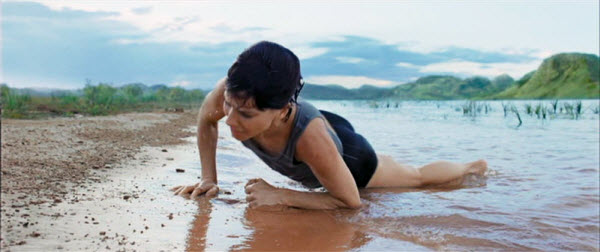“Gravity,” released in 2013 and starring Sandra Bullock and George Clooney, is hailed as one of the most realistic films depicting life in space. The film features stunning visual effects that have been praised by many, including astronauts who have experienced such conditions firsthand. It’s no surprise that the film won seven Oscars. However, despite its high quality and adherence to space science, director Alfonso Cuarón admitted that the film isn’t entirely accurate. Some scenes required significant adjustments to maintain narrative cohesion, as certain actions depicted were practically impossible in space. This article will explore these scenes and their scientific inaccuracies.

George Clooney’s Reckless Astronaut in Gravity
In “Gravity,” George Clooney’s character, astronaut Matt Kowalsky, is portrayed as recklessly floating around the space shuttle with his jetpack, talking casually and acting in a dangerously unprofessional manner. This portrayal is unrealistic, as astronauts are typically highly trained professionals who adhere to strict guidelines for space travel and conduct. Similarly, the depiction of the Indian astronaut, who throws himself to the end of his tether, is implausible, as astronauts are expected to be meticulous and avoid such risky behavior.
Astronauts Knowing Nothing About Each Other
At the beginning of the film, there is a conversation where Clooney’s character reveals that he knows nothing about Bullock’s character, Dr. Ryan Stone, including her background. This is unrealistic, as astronauts are usually well-acquainted with their colleagues before space missions. They undergo extensive training together for months, which includes learning about each other’s personal and professional backgrounds.

Communications Satellites Being Safe
In the film, the crew is informed that the Russians have destroyed a satellite in low Earth orbit (LEO), leading to imminent communication disruptions. In reality, communication satellites orbit much higher than the LEO, at altitudes up to 35,000 kilometers. Therefore, the destruction of a satellite in low Earth orbit would not affect the communication satellites used for Earth-based communications.
Sandra Bullock’s Ejection and the Impossibility of Recovery
When Sandra Bullock’s character, Dr. Ryan Stone, is ejected from the space shuttle after a collision with space debris, she seems to move at a dangerously high speed for several minutes. Clooney’s character eventually catches up with her, which is highly improbable. The vastness of space and the high velocity make it nearly impossible to locate and retrieve someone under such circumstances. If the scene adhered to real science, the film’s story would have concluded much earlier.
Transitioning from Hubble to the International Space Station
The film suggests that traveling from the Hubble Space Telescope’s orbit (559 kilometers above Earth) to the International Space Station (424 kilometers) is feasible. In reality, transitioning between these orbits is highly challenging. The film’s portrayal of using a jetpack for such a journey is more of a futuristic, fictional scenario rather than a practical reality.

Collisions in Space and Survival
“Gravity” shows astronauts surviving collisions with objects in space. In reality, such impacts would be catastrophic due to the lack of atmosphere and the extreme velocity of space debris. The film’s depiction of surviving such collisions is unrealistic, as space impacts are typically fatal.

Sandra Bullock’s Space Suit and Underwear
When Bullock’s character exits her space suit aboard the International Space Station, she is shown wearing underwear and a tight shirt. This portrayal is unrealistic, as astronauts would typically wear cooling garments and adult diapers under their suits due to the impracticality of removing a suit in space. The film’s depiction of this is more for dramatic effect than scientific accuracy.
George Clooney’s Death Scene
Some critics argue that Clooney’s character asking Bullock to leave him behind to die in space, rather than trying to save him, is scientifically inaccurate. Both characters would have the same angular momentum, making it unlikely for one to drift away from the other. The film’s suggestion that Clooney’s character should have stayed behind while Bullock retrieved a Soyuz capsule is an oversimplification of the physics involved.
Space Debris Timing
The film mentions that debris will pass by every 90 minutes, prompting Bullock to set a timer. In reality, the International Space Station orbits Earth approximately every 90 minutes, but debris is not fixed in a predictable pattern. The idea that debris would be encountered consistently every 90 minutes is inaccurate.
Tears Floating in Space
In “Gravity,” Bullock’s tears float in zero gravity, creating a visually striking effect. In reality, tears would cling to the face due to surface tension, not float freely. While this scene is visually impressive, it does not accurately represent how tears behave in space.
Distance Between Space Stations
The film implies that the International Space Station and the Chinese space station Tiangong-1 are close to each other, but in reality, they are far apart, and it’s unlikely that astronauts could travel between them as depicted.
Swimming After Space Return
Returning to Earth’s gravity after a long space mission makes physical adaptation challenging. The film’s portrayal of Bullock swimming easily after returning from space is highly unrealistic. Re-adapting to gravity requires time and is not as simple as depicted.

Spacesuit Errors
One of the film’s major errors is Bullock’s use of a Sokol suit, intended for re-entry, for spacewalking. The correct suit for spacewalks is the Orlan suit. The Sokol suit is insufficient for space exposure, making Bullock’s spacewalk highly implausible.
Ease of Returning to Spacecraft
In several scenes, Bullock quickly removes her spacesuit and enters a spacecraft or space station. In reality, astronauts must spend hours in a pressure chamber to adjust to atmospheric conditions before transitioning to regular activities.
Despite these scientific inaccuracies, “Gravity” remains a significant cinematic achievement. The film’s creators took creative liberties to maintain dramatic tension and narrative flow. Ultimately, it’s a movie designed for entertainment rather than a documentary on space travel.
